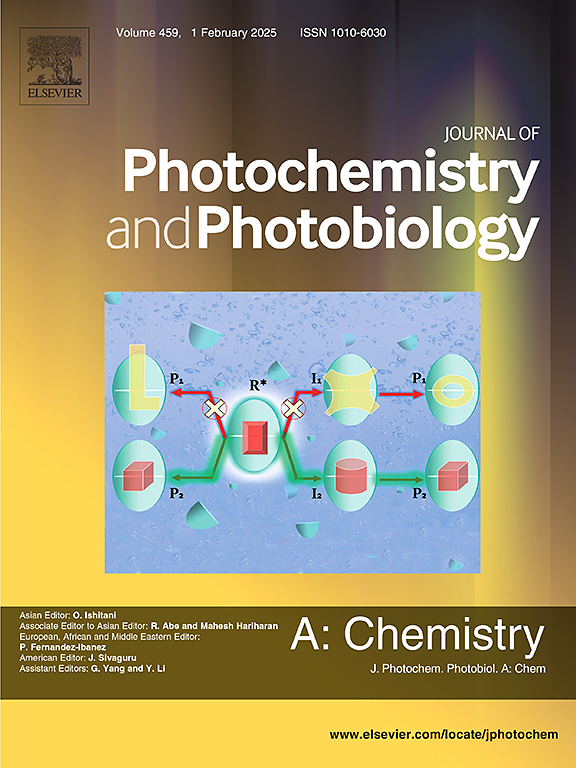Distinct roles of subphthalocyanine in the ultrafast photodynamics of three donor–acceptor conjugates directly linked by a single B-N bond revealed by nonadiabatic dynamics simulations
IF 4.1
3区 化学
Q2 CHEMISTRY, PHYSICAL
Journal of Photochemistry and Photobiology A-chemistry
Pub Date : 2025-03-27
DOI:10.1016/j.jphotochem.2025.116415
引用次数: 0
Abstract
Herein, we investigate the photodynamics of three donor–acceptor subphthalocyanine (SubPc)-based conjugates, namely SubPc-PDI, PTZ-SubPc, and PTZ-SubPcF, by leveraging the synergy of linear-response time-dependent density functional theory (LR-TDDFT) for static electronic structure analysis and nonadiabatic molecular dynamics (NAMD) simulations. Based on the obtained results, the distinct roles of SubPc in different conjugates are confirmed. In SubPc-PDI, the SubPc fragment acts as an electron donor, whereas in PTZ-SubPc and PTZ-SubPcF, it functions as an electron acceptor. Consequently, the photodynamics of these conjugates vary upon excitation around the lowest absorption band of SubPc. In the case of SubPc-PDI, energy transfer from SubPc to PDI occurs on an ultrafast timescale, completing within 500 fs. In contrast, hole transfer from SubPc/SubPcF is observed in the PTZ-SubPc/SubPcF conjugates. Furthermore, the introduction of fluorine substitution notably lowers the energy of charge transfer states in PTZ-SubPc conjugates, thereby enhancing charge transfer efficiency. The findings of our current study strongly align with previous experimental results and provide a more comprehensive understanding of the photoinduced dynamics in SubPc-based donor–acceptor systems. Additionally, the methodologies employed in this work prove effective for investigating the photodynamics of these systems, offering valuable insights for analyzing complex photodynamic behaviors in diverse organic donor–acceptor systems.

非绝热动力学模拟揭示了亚酞菁在三种由单一B-N键直接连接的给受体偶联物的超快光动力学中的独特作用
本文利用线性响应时变密度泛函理论(LR-TDDFT)进行静态电子结构分析和非绝热分子动力学(NAMD)模拟,研究了三种基于亚酞菁(SubPc)的共轭物,即SubPc- pdi、PTZ-SubPc和PTZ-SubPcF的光动力学。根据得到的结果,证实了SubPc在不同共轭体中的不同作用。在SubPc- pdi中,SubPc片段作为电子供体,而在PTZ-SubPc和PTZ-SubPcF中,它作为电子受体。因此,这些共轭物的光动力学随在SubPc最低吸收带附近的激发而变化。在SubPc-PDI的情况下,能量从SubPc到PDI的转移发生在超快的时间尺度上,在500秒内完成。相比之下,在PTZ-SubPc/SubPcF共轭物中观察到来自SubPc/SubPcF的空穴转移。此外,氟取代的引入显著降低了PTZ-SubPc共轭物中电荷转移态的能量,从而提高了电荷转移效率。我们目前的研究结果与之前的实验结果非常一致,并为基于subpc的供体-受体系统的光诱导动力学提供了更全面的理解。此外,本研究中采用的方法对于研究这些系统的光动力学是有效的,为分析不同有机供体-受体系统中复杂的光动力学行为提供了有价值的见解。
本文章由计算机程序翻译,如有差异,请以英文原文为准。
求助全文
约1分钟内获得全文
求助全文
来源期刊
CiteScore
7.90
自引率
7.00%
发文量
580
审稿时长
48 days
期刊介绍:
JPPA publishes the results of fundamental studies on all aspects of chemical phenomena induced by interactions between light and molecules/matter of all kinds.
All systems capable of being described at the molecular or integrated multimolecular level are appropriate for the journal. This includes all molecular chemical species as well as biomolecular, supramolecular, polymer and other macromolecular systems, as well as solid state photochemistry. In addition, the journal publishes studies of semiconductor and other photoactive organic and inorganic materials, photocatalysis (organic, inorganic, supramolecular and superconductor).
The scope includes condensed and gas phase photochemistry, as well as synchrotron radiation chemistry. A broad range of processes and techniques in photochemistry are covered such as light induced energy, electron and proton transfer; nonlinear photochemical behavior; mechanistic investigation of photochemical reactions and identification of the products of photochemical reactions; quantum yield determinations and measurements of rate constants for primary and secondary photochemical processes; steady-state and time-resolved emission, ultrafast spectroscopic methods, single molecule spectroscopy, time resolved X-ray diffraction, luminescence microscopy, and scattering spectroscopy applied to photochemistry. Papers in emerging and applied areas such as luminescent sensors, electroluminescence, solar energy conversion, atmospheric photochemistry, environmental remediation, and related photocatalytic chemistry are also welcome.

 求助内容:
求助内容: 应助结果提醒方式:
应助结果提醒方式:


